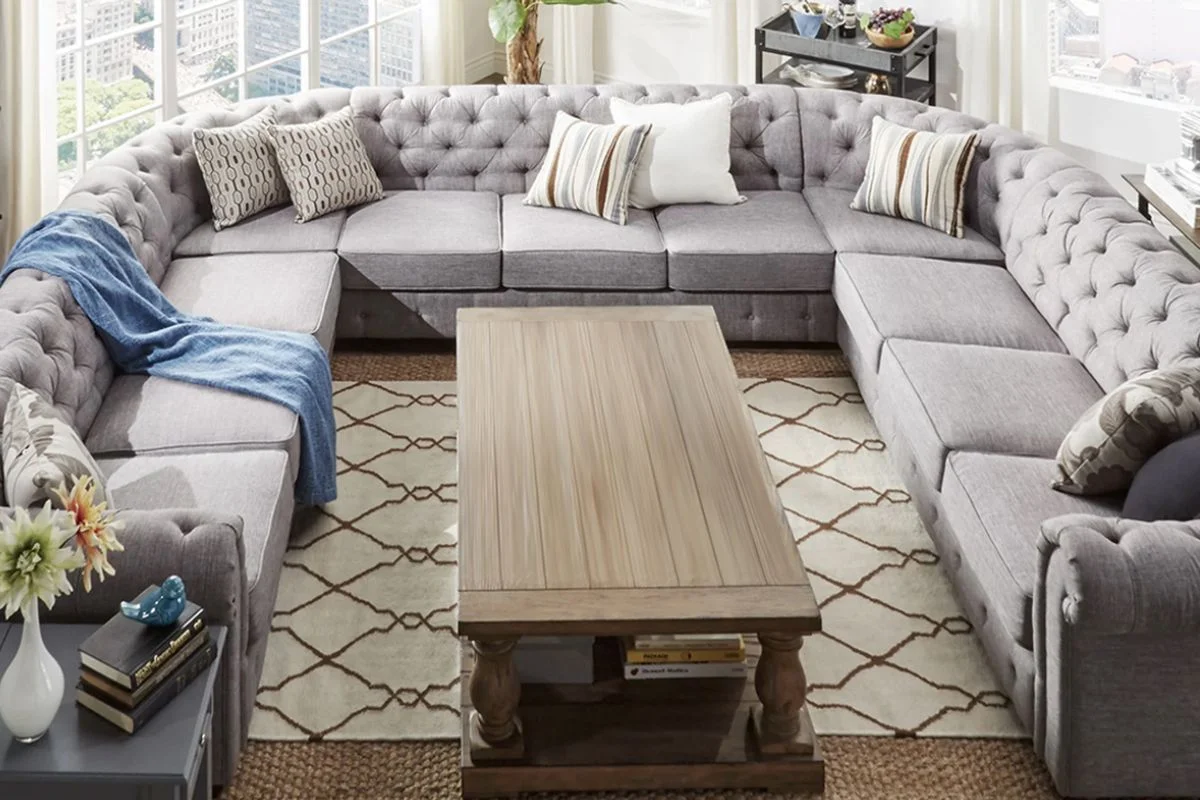Your sofa is more than just a piece of furniture; it’s a centerpiece of comfort and relaxation in your home. However, over time, daily wear and tear can take a toll on your sofa, leading to issues such as tears, stains, and structural damage.
But fear not! With the right knowledge and techniques, you can tackle sofa repair like a pro, restoring your beloved piece to its former glory. In this comprehensive guide, we’ll take you through a variety of tips and techniques for sofa repair, covering everything from minor touch-ups to major structural fixes.
Whether you’re dealing with a torn upholstery, sagging cushions, or a broken frame, this guide has you covered. Get ready to roll up your sleeves and learn how to revive your sofa and extend its lifespan, saving you time and money in the process. So, let’s dive in and discover the ultimate secrets to sofa repair!
Importance of Sofa Repair in Extending Furniture Lifespan
Your sofa is more than just a piece of furniture; it’s a central element of your living space where you relax, entertain guests, and create memories with loved ones. However, frequent use and everyday wear and tear can take a toll on your sofa, leading to various issues such as tears, stains, sagging cushions, and structural damage.
Sofa repair plays a crucial role in extending the lifespan of your furniture and preserving its functionality and appearance. By addressing minor issues promptly and conducting regular maintenance, you can prevent small problems from escalating into larger, more costly repairs or the need for premature replacement.
Additionally, sofa repair offers several key benefits for homeowners:
Cost-Effectiveness: Repairing minor issues is often more cost-effective than replacing the entire sofa. By investing in sofa repair, you can extend the lifespan of your furniture and avoid the expense of purchasing a new one.
Sustainability: Repairing and refurbishing your sofa reduces waste and contributes to sustainability efforts by minimizing the need for new furniture production. By extending the lifespan of your sofa through repair, you can reduce your environmental impact and promote eco-friendly living practices.
Preservation of Sentimental Value: Many sofas hold sentimental value for homeowners, whether they’ve been passed down through generations or are associated with special memories and experiences. Repairing and maintaining your sofa allows you to preserve its sentimental value and continue enjoying its presence in your home for years to come.
Enhanced Comfort and Functionality: Addressing issues such as sagging cushions or broken frames through sofa repair can improve the comfort and functionality of your furniture. By restoring its structural integrity and addressing wear and tear, you can ensure that your sofa remains a comfortable and functional centerpiece of your living space.
Tools and Materials Needed for Sofa Repair
Before you embark on repairing your sofa, it’s essential to gather the necessary tools and materials to ensure a successful outcome. Here’s a list of tools and materials you’ll need for sofa repair:
Essential Tools:
Screwdriver set: To tighten screws and fasteners on the sofa frame.
Pliers: For gripping and pulling staples, nails, or upholstery tacks.
Staple gun: To secure new upholstery fabric or repair loose upholstery.
Upholstery scissors: For cutting fabric and trimming excess material.
Needle-nose pliers: For reaching tight spaces and bending wire.
Utility knife: For cutting foam, batting, and upholstery fabric.
Measuring tape: To measure fabric dimensions and ensure accurate cuts.
Hammer: For driving nails and securing wooden components.
Sewing kit: Including needles, thread, and upholstery repair thread for sewing seams and repairing tears.
Upholstery pins: To temporarily hold fabric in place while working.
Recommended Materials:
Upholstery fabric: Choose a durable fabric that complements your sofa’s style and color scheme.
Batting or foam padding: For adding cushioning and support to sagging cushions.
Upholstery webbing or straps: To reinforce or replace sagging springs or webbing.
Upholstery tacks or nails: For securing fabric to the sofa frame.
Wood glue: For repairing loose joints or frames.
Wood filler: To fill in gaps or holes in wooden frames.
Leather repair kit: Including leather patches, adhesive, and color-matching dye for repairing tears, scratches, or stains on leather upholstery.
Fabric adhesive: For securing loose seams or edges of upholstery fabric.
Furniture conditioner: To moisturize and protect leather upholstery from drying out and cracking.
Stain remover or cleaner: For treating stains and spills on fabric or leather upholstery.
Cost-Effective Solutions for Sofa Repair on a Budget
Repairing your sofa doesn’t have to break the bank. With some creativity and resourcefulness, you can implement cost-effective solutions to address common sofa issues without spending a fortune. Here are some budget-friendly tips for sofa repair:
DIY Upholstery Repair: Instead of hiring a professional upholsterer, consider tackling minor upholstery repairs yourself. Purchase upholstery fabric patches or repair kits from craft stores and follow online tutorials to patch tears, holes, or scratches in your sofa’s upholstery.
Repurpose Materials: Look for creative ways to repurpose materials you already have at home for sofa repair. Old blankets or quilts can be used as temporary cushion covers, while leftover fabric scraps can be used to patch small tears or cover worn areas.
Use Household Items: Many common household items can be repurposed for sofa repair. For example, a mixture of vinegar and baking soda can help remove stains from fabric upholstery, while olive oil can be used to condition and moisturize leather upholstery.
Opt for Pre-Owned Furniture: If your sofa is beyond repair or requires extensive restoration, consider purchasing pre-owned furniture as a cost-effective alternative to buying new. You can often find high-quality sofas at thrift stores, online marketplaces, or garage sales at a fraction of the cost of new furniture.
DIY Structural Repairs: Minor structural issues such as loose joints or sagging cushions can often be repaired with basic tools and materials. Use wood glue to reinforce loose joints, or add extra padding to sagging cushions using foam padding or batting purchased from a craft store.
Compare Repair vs. Replacement Costs: Before investing in sofa repair, weigh the costs of repair against the cost of replacement. In some cases, it may be more cost-effective to repair your sofa, especially if it’s a high-quality piece with sentimental value or if the repairs are minor.
Negotiate Repair Quotes: If you decide to hire a professional for sofa repair, don’t be afraid to negotiate repair quotes to get the best possible price. Shop around and compare quotes from different repair services, and don’t hesitate to ask for discounts or negotiate lower prices based on your budget constraints.
Leather Sofa Repair: Techniques for Fixing Tears, Scratches, and Stains
Leather sofas add a touch of elegance and sophistication to any living space, but over time, they can develop tears, scratches, and stains that detract from their beauty. Fortunately, with the right techniques, you can repair these issues and restore your leather sofa to its original condition. Here are some effective techniques for fixing tears, scratches, and stains on leather sofas:
Repairing Tears:
- Clean the area around the tear with a mild soap and water solution to remove dirt and grime.
- Use a leather repair kit containing patches or adhesive to repair the tear. Cut a patch from the kit that is slightly larger than the tear.
- Apply the adhesive to the back of the patch and carefully place it over the tear, pressing down firmly to ensure adhesion.
- Allow the adhesive to dry completely before using the sofa.
Buffing Scratches:
- For minor scratches, gently buff the affected area with a soft cloth or a leather conditioning cream. This can help blend the scratch into the surrounding leather and minimize its appearance.
- For deeper scratches, use a leather repair kit containing a filler compound. Apply the filler to the scratch, following the manufacturer’s instructions, and smooth it out with a spatula or applicator tool.
- Allow the filler to dry completely before buffing the area with a soft cloth to blend it with the surrounding leather.
Treating Stains:
- For surface stains, blot the affected area with a clean, damp cloth to remove as much of the stain as possible.
- Use a leather cleaner or mild soap and water solution to gently clean the stained area, working in small circular motions.
- For stubborn stains, apply a leather stain remover according to the manufacturer’s instructions. Be sure to test the remover on a small, inconspicuous area of the sofa first to ensure it doesn’t cause discoloration.
- Once the stain is removed, rinse the area with clean water and allow it to dry completely before conditioning the leather with a leather conditioner or moisturizer.
Preventative Maintenance Tips to Keep Your Sofa in Top Condition
Maintaining your sofa in prime condition not only preserves its appearance but also extends its lifespan, ensuring years of comfort and enjoyment. Here are some preventative maintenance tips to help you keep your sofa looking and feeling its best:
Regular Cleaning: Dust and debris can accumulate on your sofa’s surface, leading to discoloration and deterioration over time. To prevent this, vacuum your sofa regularly using a soft brush attachment to remove dust, crumbs, and pet hair. Additionally, wipe down the upholstery with a slightly damp cloth or microfiber cloth to remove surface dirt and grime.
Rotate Cushions: To ensure even wear and prolong the life of your sofa cushions, rotate them regularly. This helps distribute weight and pressure more evenly, preventing one side of the cushions from becoming flattened or misshapen.
Avoid Direct Sunlight: Prolonged exposure to direct sunlight can cause the upholstery fabric or leather on your sofa to fade and deteriorate. To prevent this, position your sofa away from windows or use curtains, blinds, or UV-blocking window film to shield it from harmful UV rays.
Use Arm Covers: If your sofa has fabric upholstery, consider using arm covers to protect the arms from oils, sweat, and dirt from hands and arms. This helps prevent discoloration and staining on the fabric upholstery, keeping your sofa looking fresh and clean.
Keep Pets Off: Pets can cause damage to sofas with their claws, fur, and accidents. Train your pets to stay off the sofa or use pet-proof covers to protect the upholstery from scratches, stains, and odors.
Address Spills Promptly: Accidents happen, but it’s crucial to address spills and stains on your sofa promptly to prevent them from setting in and becoming more difficult to remove. Blot spills immediately with a clean cloth or paper towel, then clean the affected area with a mild soap and water solution or a stain remover recommended for your sofa’s upholstery type.
Conclusion
Maintaining your sofa in top condition is essential for preserving its beauty, comfort, and longevity. By implementing the preventative maintenance tips outlined in this guide, you can ensure that your sofa remains a stylish and inviting centerpiece of your living space for years to come.




